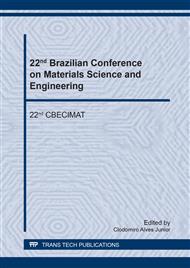p.374
p.380
p.386
p.390
p.395
p.400
p.405
p.411
p.416
Study of the Abrasion Resistance of Fe-Cu-Nb and NEXT 100® Metallic Matrices for the Manufacture of Diamond Tools
Abstract:
The substitution of cobalt, present in the commercial binder metal matrix commonly used by the industry, was analyzed: 25,2%Fe-49,5%Cu-24,1%Co – NEXT 100® by the niobium element of the Fe-Cu-Co system, obtaining 4 metal matrices: 28,34%Fe–56,66%Cu–15%Nb; 25%Fe–50%Cu–25%Nb; 21,67%Fe–43,33%C–35%Nb; 18,34%Fe–36,66%Cu–45%Nb. This study aims to evaluate the behavior of metal matrices to better choose the type of matrix to be used in the manufacture of diamond tools. The metal powders were blended according to the compositions of each metal matrix and then hot pressed at 800o /35MPa / 3min, thus occurring the sintering. The sintered samples of each metal matrix were conducted to the Abrasion Resistance test in order to verify the wear, for the accumulated times of 2, 6, 12 and 20 minutes. In these metal matrices, density, porosity and Vickers hardness (HV5) tests were performed to better understand the wear suffered by the samples. Thus, the metal matrix 25% Fe-50%Cu-25%Nb presented, in the general context of the properties and from the abrasive point of view, satisfactory results capable of replacing the NEXT 100 matrix.
Info:
Periodical:
Pages:
395-399
Citation:
Online since:
September 2018
Keywords:
Price:
Сopyright:
© 2018 Trans Tech Publications Ltd. All Rights Reserved
Share:
Citation:


